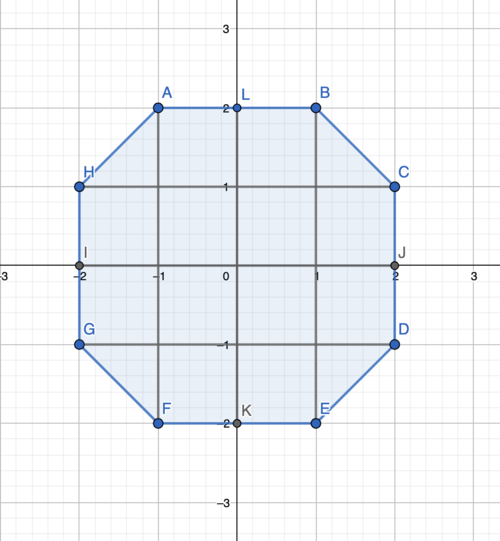2005 AMC 10A Problems/Problem 20
Problem
An equiangular octagon has four sides of length ![]() and four sides of length
and four sides of length ![]() , arranged so that no two consecutive sides have the same length. What is the area of the octagon?
, arranged so that no two consecutive sides have the same length. What is the area of the octagon?
![]()
Solution 1
The sum of the octagon's angles is ![]() , so since it is equiangular, each angle is
, so since it is equiangular, each angle is ![]() , i.e. the same as in a regular octagon. This means that this octagon, just like with a regular octagon, can be divided into squares (whose diagonals form
, i.e. the same as in a regular octagon. This means that this octagon, just like with a regular octagon, can be divided into squares (whose diagonals form ![]() angles) and right triangles.
angles) and right triangles.
In particular, as shown in the diagram below, the area of this octagon can be divided up into ![]() squares of side length
squares of side length ![]() and
and ![]() right triangles, each of which has half the area of each of the squares (since each square has diagonal
right triangles, each of which has half the area of each of the squares (since each square has diagonal ![]() , so each right triangle is congruent by side-side-side to one of the triangles formed by slicing a square along one of its diagonals).
, so each right triangle is congruent by side-side-side to one of the triangles formed by slicing a square along one of its diagonals).
Therefore, the area of the octagon is equal to the area of ![]() of the squares, and the area of each square is simply
of the squares, and the area of each square is simply  , so the answer is is
, so the answer is is ![]() .
.
![[asy] pair A=(0.5, 0), B=(0, 0.5), C=(0, 1.5), D=(0.5, 2), E=(1.5, 2), F=(2, 1.5), G=(2, 0.5), H=(1.5, 0); draw(A--B); draw(B--C); draw(C--D); draw(D--E);draw(E--F);draw(F--G); draw(G--H); draw(H--A);draw(A--F, blue);draw(E--B,blue);draw(C--H, blue); draw(D--G,blue);dot(A);dot(B);dot(C);dot(D);dot(E);dot(F);dot(G);dot(H); [/asy]](http://latex.artofproblemsolving.com/c/5/5/c555a9225f3304367b0d7f6c435ec5293f27dff4.png)
Solution 2
Using the same diagram as in Solution 1, we can extend the sides of length ![]() to form a bounding square around the octagon, with the region inside the square but outside the octagon consisting of
to form a bounding square around the octagon, with the region inside the square but outside the octagon consisting of ![]() right triangles. (We could also extend the sides of length
right triangles. (We could also extend the sides of length ![]() to give a similar bounding square, but this would make the computations slightly harder.)
to give a similar bounding square, but this would make the computations slightly harder.)
As in Solution 1, since all the interior angles of the octagon are ![]() , the right triangles are all
, the right triangles are all ![]() triangles with hypotenuse
triangles with hypotenuse ![]() . Thus the length of their other legs is
. Thus the length of their other legs is  , so the bounding square has total side length
, so the bounding square has total side length ![]() , and hence area
, and hence area ![]() . Each of the right triangles has area
. Each of the right triangles has area ![]() , so we deduce that the area of the octagon is
, so we deduce that the area of the octagon is ![]() .
.
edited by mobius247
Solution 3
As shown in the diagram below, we can also divide the octagon into squares and right triangles using horizontal and vertical lines, rather than the lines at a ![]() angle that were used in Solutions 1 and 2.
angle that were used in Solutions 1 and 2.
(Diagram made using Geogebra)
For the same reasons as in Solutions 1 and 2, the octagon's ![]() interior angles mean that the right triangles are
interior angles mean that the right triangles are ![]() triangles with hypotenuse
triangles with hypotenuse ![]() , so their other legs have length
, so their other legs have length  . Accordingly, their areas are each
. Accordingly, their areas are each ![]() , while by symmetry, each of the squares also has side length
, while by symmetry, each of the squares also has side length ![]() , and thus area
, and thus area ![]() .
.
Hence, as the octagon consists of ![]() squares and
squares and ![]() right triangles, its total area is
right triangles, its total area is ![]() .
.
~JH. L
Video Solution
See Also
| 2005 AMC 10A (Problems • Answer Key • Resources) | ||
| Preceded by Problem 19 |
Followed by Problem 21 | |
| 1 • 2 • 3 • 4 • 5 • 6 • 7 • 8 • 9 • 10 • 11 • 12 • 13 • 14 • 15 • 16 • 17 • 18 • 19 • 20 • 21 • 22 • 23 • 24 • 25 | ||
| All AMC 10 Problems and Solutions | ||
These problems are copyrighted © by the Mathematical Association of America, as part of the American Mathematics Competitions. ![]()










